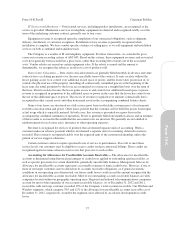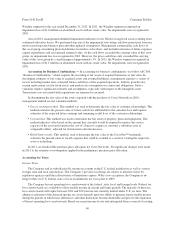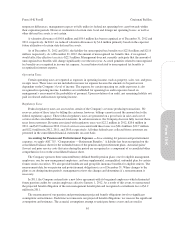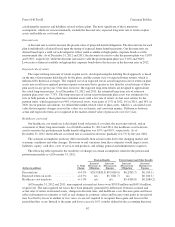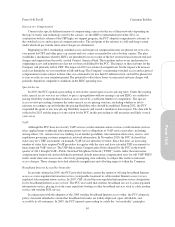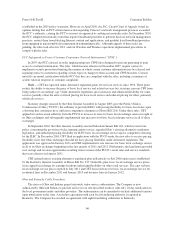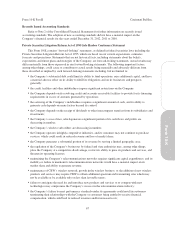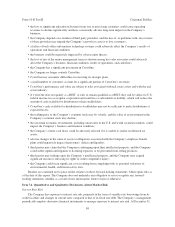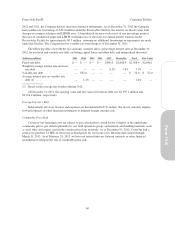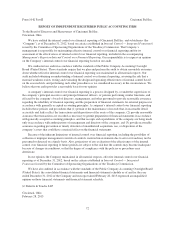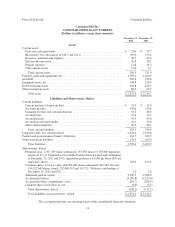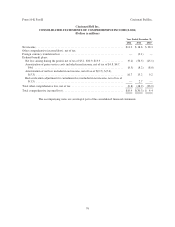Cincinnati Bell 2012 Annual Report Download - page 140
Download and view the complete annual report
Please find page 140 of the 2012 Cincinnati Bell annual report below. You can navigate through the pages in the report by either clicking on the pages listed below, or by using the keyword search tool below to find specific information within the annual report.established in the 2005 policy statement. However, in April 2010, the D.C. Circuit Court of Appeals issued an
opinion finding that an FCC enforcement action regarding Comcast’s network management practices exceeded
the FCC’s authority, causing the FCC to reassess its approach to crafting net neutrality rules. In December 2010,
the FCC adopted net neutrality rules that require broadband providers to publicly disclose network management
practices, restrict them from blocking Internet content and applications, and prohibit fixed broadband providers
from engaging in unreasonable discrimination in transmitting traffic. Although appeals of these rules are
pending, the rules took effect in 2011, and our Wireline and Wireless operations implemented procedures to
comply with the rules.
FCC Safeguards to Protect Customer Proprietary Network Information (“CPNI”)
In 2007, the FCC released an order implementing new CPNI rules designed to prevent pretexting to gain
access to customer information. The rules, which became effective in December 2007, require carriers to
implement security protections limiting the manner in which certain customer information may be released and
requiring notice to customers regarding certain types of changes to their account and CPNI breaches. Carriers
must file an annual certification with the FCC that they are compliant with the rules, including a summary of
actions taken in response to customer complaints.
State — CBT has operated under alternative regulation plans for its local services since 1994. These plans
restrict the ability to increase the price of basic local service and related services but, in return, prevent CBT from
being subject to an earnings cap. Under alternative regulation, price increases and enhanced flexibility for some
services partially offset the effect of fixed pricing for basic local service and reduced pricing for other, primarily
wholesale services.
Statutory changes enacted by the Ohio General Assembly in August 2005 gave the Public Utilities
Commission of Ohio (“PUCO”) the authority to provide ILECs with pricing flexibility for basic local rates upon
a showing that consumers have sufficient competitive alternatives (House Bill 218). Under these rules, CBT
applied for and received authority from the PUCO to increase its rates for basic local exchange service in eight of
its Ohio exchanges and subsequently implemented rate increases for basic local exchange service in all of these
exchanges.
In September 2010, the Ohio General Assembly enacted Substitute Senate Bill 162, which revised state
policy concerning the provision of telecommunications service, repealed Ohio’s existing alternative regulation
legislation, and authorized pricing flexibility for ILEC basic local exchange service upon a competitive showing
by the ILEC. In December 2010, CBT filed an application with the PUCO under the new rules to receive pricing
flexibility in its four Ohio exchanges that did not have pricing flexibility under alternative regulation. The
application was approved in January 2011 and CBT implemented a rate increase for basic local exchange service
in all of its Ohio exchanges beginning in the first quarter of 2011 and 2012. Furthermore, the legislation provided
cost savings and revenue opportunities resulting from revision of the PUCO’s retail rules and service standards
that were effective in January 2011.
CBT entered into its existing alternative regulation plan in Kentucky in July 2006 under terms established
by the Kentucky General Assembly in House Bill No. 337. Under this plan, basic local exchange service prices
were capped in exchange for earnings freedom and pricing flexibility on other retail services. The caps on basic
local exchange service prices expired in July 2011 and CBT increased rates for basic local exchange service for
residential lines in December 2011 and January 2013 and business lines in January 2012.
Ohio and Kentucky Cable Franchises
The states of Ohio and Indiana permit statewide video service authorization. The Company is now
authorized by Ohio and Indiana to provide service in our self-described territory with only 10-day notification to
the local government entity and other providers. The authorization can be amended to include additional territory
upon notification to the state. A franchise agreement with each local franchising authority is required in
Kentucky. The Company has reached an agreement with eight franchising authorities in Kentucky.
66
Form 10-K Part II Cincinnati Bell Inc.



